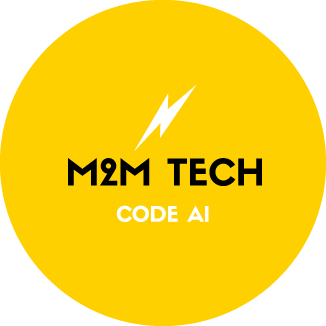As artificial intelligence becomes more integrated in our personal lives and business operations, one may wonder how they can adapt and advance in their career through this technology. For students with high interest but limited experience, this uphill climb seems intimidating or even out of reach. However, there are concrete pathways to make this rewarding journey possible for those wanting to be part of future innovations and disruptive inventions.
My journey began in my first year when I had limited coding skills and no AI knowledge. Unsure about my future career trajectory, I was initially seeking math-related jobs in finance. After coming across M2M Tech courses and programs, I picked up data science and machine learning fundamentals. Along with my math background, this newly developed skill set has helped me start my career.
Currently, I am a Machine Learning Intern with M2M Tech. Having done multiple client projects and course development over the past 8 months, I have worked in a startup environment with some of the latest AI industry applications. Through this blog, I hope to help aspiring high school and post-secondary students understand and get into AI.
What Background is Needed to Enter the Field?
You've likely heard that understanding math and statistics is important in machine learning. Many areas such as linear algebra, calculus, discrete math and statistics are often mentioned. Additionally, I would like to introduce further areas that are helpful to understanding AI applications and algorithms:
- Regression analysis: a statistical method for estimating the relationships between a dependent variable and one or more independent variables. Often used in business, science, and other applications because of simple implementation, high accuracy and easy interpretation.
- Time series analysis: statistical methods that analyze data points measured over time. Often used for trend discovery and forecasting in finance, healthcare, engineering, and other areas to predict how variables will behave.
- Stochastic processes: a sequence of data over time where data points appear based on a probability distribution. Used in AI algorithms such as stochastic gradient descent and Markov decision processes.
Although you can find many more areas and applications beyond the above, it's not mandatory to become a math expert before entering machine learning. However, delving deeper into math, statistics, and computer science subfields is helpful for holistic understanding and discovering meaningful applications.
Building industry AI applications requires skills that overlap with software engineering. Here are some essential technologies to have in your toolkit:
- Python: The most widely used language in AI with libraries like NumPy, pandas, and TensorFlow.
- R: Another popular language with its own machine learning libraries.
- SQL: Needed for querying and managing data that will be put into machine learning algorithms.
- Power BI/Tableau: Helps visualize and explain data to non-technical audiences, leading to better understanding and data-driven decision making.
- Git: Helpful for version control as you develop machine learning solutions within team projects.
For courses to help you get into data science, machine learning and AI, there are free online options. The M2M Tech courses I've taken can be found in our annual membership programs, which also include projects that apply your knowledge to current industry problems. I found this project aspect to be the most important for effective learning; rather than having to learn on your own, you get access to direct feedback from a community of active learners. This helps address knowledge gaps and implementation errors that beginners often make.
How and Where to Break into Related Roles
One difficulty of breaking into technical and machine learning related roles is the subject knowledge gap as mentioned above. However, here are some practical tips to help you with this process:
- Join communities and competitions: Much like our annual memberships, finding like-minded people to learn from can speed up your journey and put some preliminary experiences on your resume. Firstly, doing hackathons can be a great way to sharpen your skill set and present projects that apply machine learning. In addition to courses, there are also online communities discussing machine learning topics. If possible, you can also join or create AI-related clubs where you can learn and teach each other.
- Look for AI-adjacent roles: As AI becomes more prevalent in the business environment, companies are at different stages of AI adoption and therefore look for different types of talent. Therefore, getting an entry point into related positions is important. Here are some example roles you can look for:
- Data Analyst: Handles data cleaning, transformation and preparation to feed into algorithms.
- Software Developer: Gain experience in coding and problem-solving. Focusing on machine learning projects or products helps with transitioning into AI-heavy roles.
- University Research Assistant: Working with professors on data-intensive projects or novel AI research develops unique skills and puts you at the frontier of AI innovations.
- Look for the right companies: Some companies are adopting AI into their operations or core business offer, while others aren't quite ready to do so. Here are the types of companies to look out for:
- AI startups: Usually have AI as part of their core offering.
- Small and medium-sized enterprises (SMEs): Can be from any industry and have a small-medium technical team with data analytics and potentially machine learning capabilities.
- Established tech companies: Have fully established teams for machine learning applications compared to SMEs and are looking to improve their current technology.
Generally, the above enterprise types will have the best chances for open data, ML and AI openings. However, opportunities outside industry also exist. It's up to you to look and apply!
- Network: After identifying fitting companies for you, reach out through email or LinkedIn to express interest in their roles. It's also beneficial to attend tech networking events and job fairs if you know these companies are attending. Don't be afraid to make yourself known to other professionals and potential employers!
Breaking into AI is challenging but achievable with the right mindset and strategy. Start by building a strong foundation in math, coding, and AI concepts. Focus on projects to demonstrate your skills, and leverage internships and networking opportunities to gain real-world experience. Most importantly, stay curious and keep learning!
If you're a working professional wanting to grow your experience and network, M2M Tech's 16-week DataTalent program connects you with employers for real-world projects and career development in a cohort style.
Interested in working with our team at M2M Tech? Check out our Business Accelerator or connect with us at contact@m2mtechconnect.com
Contact Us






